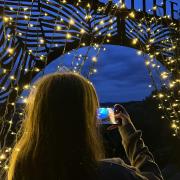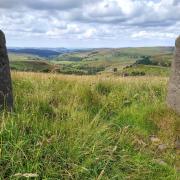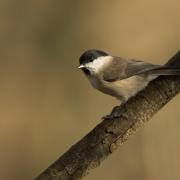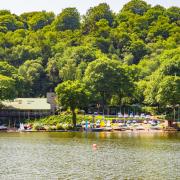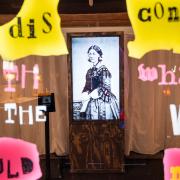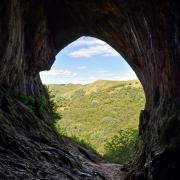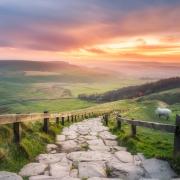Kinder – probably the most iconic landmark in the Peak District; it’s also the National Park’s highest point.
There are several ways to approach the extensive Kinder Massif. The route up Jacob’s Ladder from Edale is a much-loved if arduous approach via the Pennine Way.
The approach from Hayfield village and Hayfield Reservoir onto the edge is probably the most popular.
I’ve done both, but if you want to avoid the steep climb from the valley floor, you can set out from Snake Pass at its highest point – where the Pennine Way heads off towards Bleaklow in one direction and Kinder in the other.
This hike is mostly flat (or at least gently undulating) except for a short, sharp climb up the escarpment above Ashop Moor onto the higher reaches of Kinder Scout.

At 633 metres (2076 ft) it’s, strictly speaking, not the highest point on the massif. You would have to stride out northeast from the marker across the bog to its highest point at 636 metres.
I’m not a purist, so I was happy to bow to the trig point. This is a there-and-back hike, one to do on a clear day after a dry spell.
Make sure you’re prepared for high-level walking. Wear sturdy boots and take layers of clothes for changeable weather, including waterproofs.
Pack a compass and paper map as back up to any walking app and stick to the path which is clearly defined and easy to follow if the mists haven’t come down.
On clear days, of course, the views are stunning with wild nature all around you on one hand and the incongruous skyscrapers of the big city – Manchester – at your feet on the other.
1. Park in the layby at the side of Snake Pass summit. Here the Pennine Way dissects the road, linking Kinder Scout and Bleaklow. Warning: make sure you don’t park behind yellow lines – it's still illegal and liable to fines.
Go through the gate with the National Trust sign marked Ashop Moor and head across the flagstones. It should take around an hour to reach Mill Hill, the first place providing somewhere to sit down and have a drink or snack.
Along the way the plateau of moorland stretches out on both sides. At first the terrain appears featureless, but the blanket bog is home to many upland birds, moths, mosses, heather, bilberry bushes and even lizards.
In summer, bog cotton covers the moorland like balls of snow. Later, bright purple heather brings dazzling colour to the moors.
Enjoy this easy stretch – it's not much different from the easy pavement walking of the high-rise city below, except you are in the wilds of the Peak’s highest reaches. Be aware, some of the flagstones are unstable on the underlying bog, with a few submerged in the peaty water.

Continue straight (following the Edale pointer) to climb steeply up steps onto the higher reaches of Kinder above the bluff. This is the only steep climb on the walk and will give your lungs a good work-out, but it is a short climb in comparison to the approaches from Edale and Hayfield.
3. From the rocks of Sandy Heys go through two sets of wooden gates, descending to Kinder Downfall. From here the path follows the edge round to Kinder Downfall, not quite so easy now as the ground is uneven with rocks protruding underfoot.
As the path draws close to Kinder Downfall, it hugs the precipitous drops. Watch your step and take care in any mists as you approach the waterfall.
Kinder Downfall is a magical place – the perfect location for a picnic lunch. The River Kinder gently flows along the flat plateau before plunging into the rocky gorge.
In summer the trickle of waterfall is, to be honest, not that impressive, but on breezy days, and in periods after a lot of rain, the flow of water pushed back uphill by the wind appears to defy gravity. In severe winters, you may see rock climbers scale the frozen waterfall with ice-picks in hand.

The path continues along the edge until it appears to divide. If you are using the OS map, note that the marked Pennine way is not quite accurate here. Keep to the clearly defined path of crunchy gritstone that meanders around and over slabs of rock.

Sit down on one of the rocks, catch your breath and enjoy the views over to Manchester, its conurbations, the Cheshire Plain (even north Wales on a clear day) and, of course, the uplands of both the White Peak and Dark Peak.
All that remains is to gather your strength, turn round and retrace your steps back to the summit of Snake Pass.
COMPASS POINTS
DISTANCE: 11.5 miles
GRID REFERENCE: SK 0880 9290
MAP: OS Leisure Map OL01 Peak District Dark Peak
DIFFICULTY: Moderate. Easy York stone pavement walking initially, stiff climb on the escarpment, uneven ground but flattish
REFRESHMENTS: none on the route – bring a picnic




